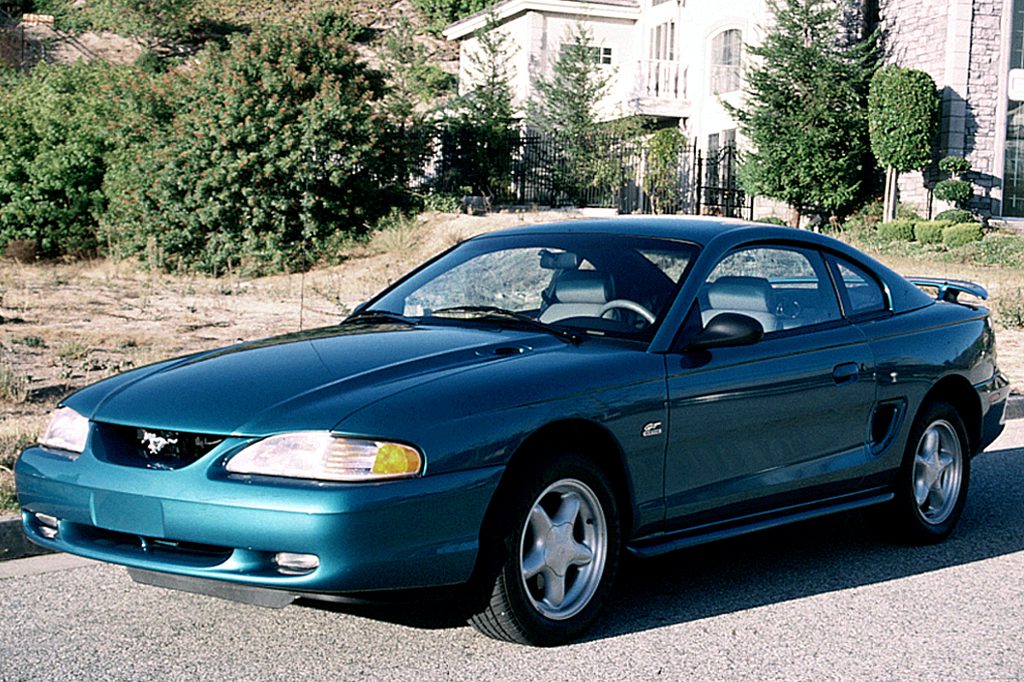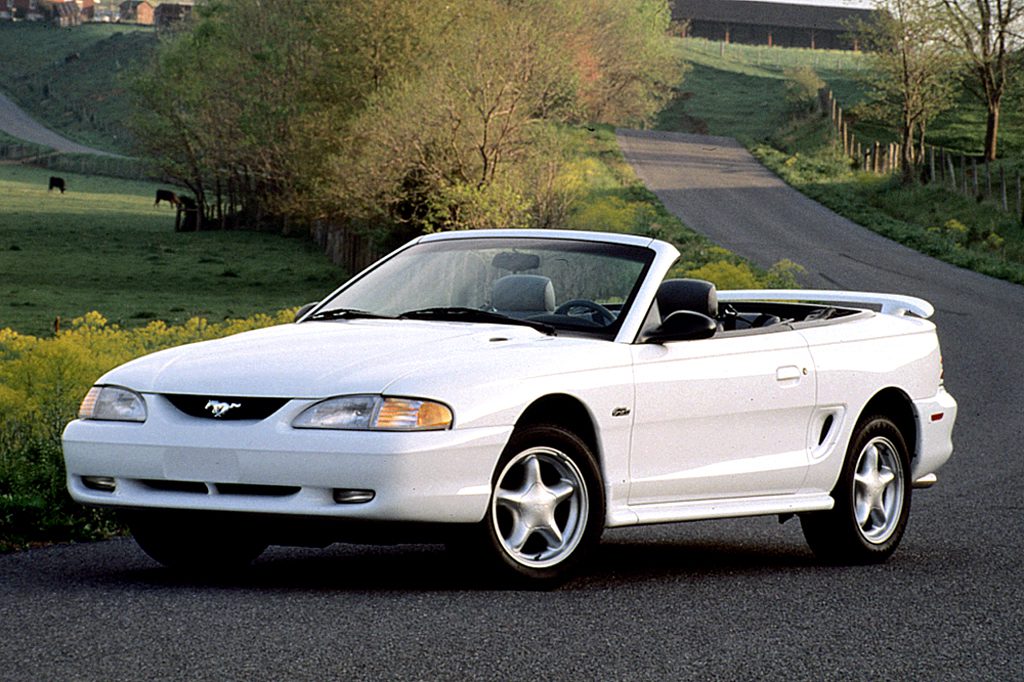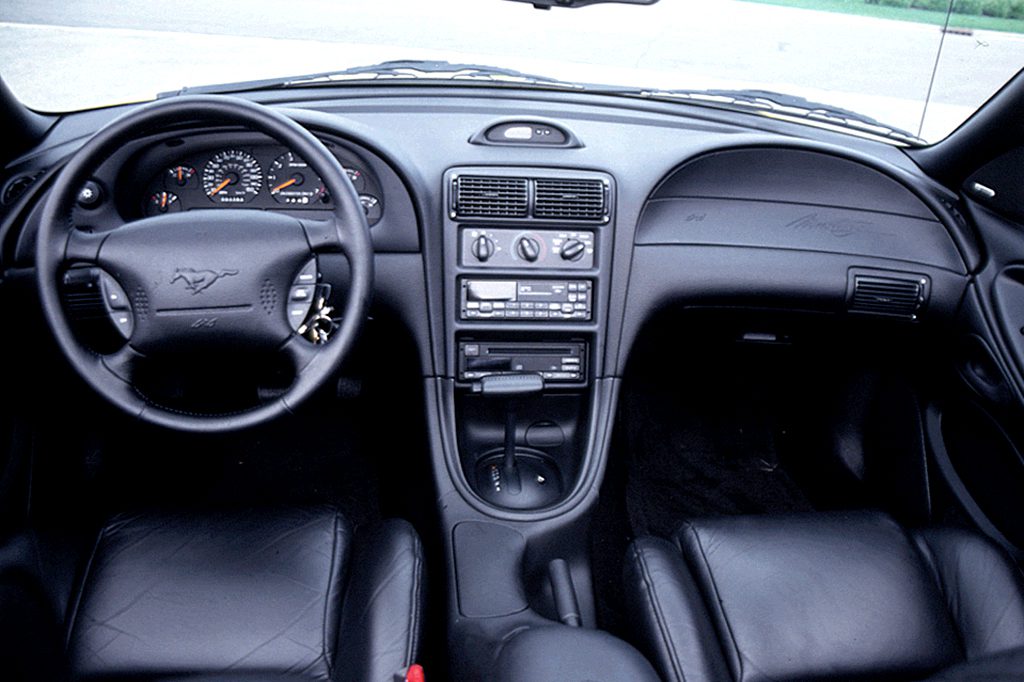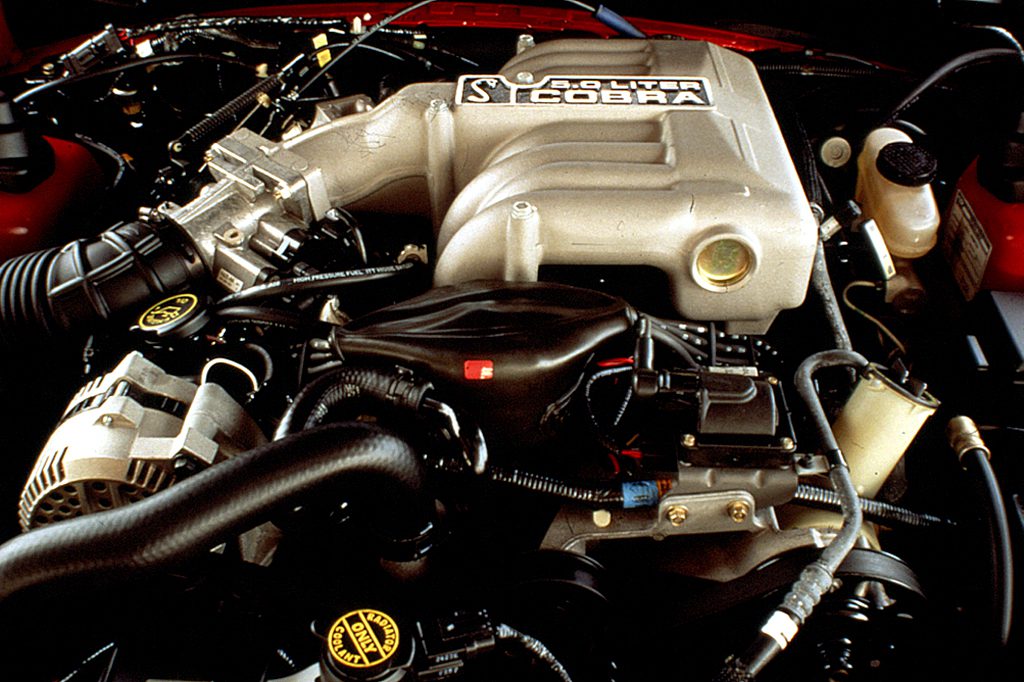| Sporty/performance car; Built in USA |
|
|
| Good condition price range: $1,700 – $17,000* |

1994 Ford Mustang GT 2-door coupe

1996 Ford Mustang GT 2-door convertible

1994 Ford Mustang GT 2-door coupe

1994 Ford Mustang GT interior

1994 Ford Mustang Cobra engine
| Pros: |
|
| Cons: |
|
Cobras can be pricey, and don’t expect discounts on the limited-production Bullitt. Overall, though, Mustang delivers sporty performance at a reasonable price–especially in base and GT form. A major improvement over its predecessor, and more user-friendly for everyday driving than Chevy’s Camaro, the current Mustang is well worth a test drive.
Overview
Still rear drive, Ford’s popular ponycar gained new sheetmetal and dual airbags in its long-overdue redesign for 1994. Hatchbacks disappeared, but a notchback coupe and convertible remain. Exterior and interior dimensions changed only a little. Four-cylinder engines were gone. Base models got a V6 engine, while the GT held a 215-horsepower V8. Manual shift was standard; electronically controlled 4-speed automatic optional. All Mustangs now halted with all-disc brakes, with antilocking an option for the first time. Convertibles included a power top and glass rear window, with a rear defogger optional. Mustang Cobras with 240-horsepower V8s were sold only in limited quantity. Firmer suspended than ordinary Mustangs, Cobras came only with 5-speed manual shift and had all-disc antilock braking as well as a unique appearance.
Yearly Updates
| 1995 Mustang No major changes hit the Mustang in its second season in mid-1990s form. |
| 1996 Mustang For 1996, a 4.6-liter overhead-cam V8 replaced the 5.0-liter. Special high-performance Cobras got a 305-horsepower dual-overhead-cam version. Cobra coupes arrived first, followed later by a convertible. Each engine gained platinum-tipped spark plugs, and the V6 added five horsepower. |
| 1997 Mustang Notable changes included the following: a monotone interior color scheme, “flecked” seat fabric pattern for the GT, optional gray leather interior for the convertible, and optional “diamond-cut” 17-inch alloy wheels for the GT. |
| 1998 Mustang Mustang returns virtually unchanged except for ten more horsepower in the GT. |
| 1999 Mustang Mustang got a major styling makeover for ’99. Included were new front and rear clips with styling cues from the original 1965 model and a new rear suspension designed to improve handling. All models returned and the Cobra got an even more-impressive fully independent rear suspension. |
| 2000 Mustang Except for a new Sport appearance option for the V6 Mustang, changes were few this year. The Sport appearance group included a rear spoiler, bright alloy wheels, and body stripes. All models got two rear child safety-seat anchors and a tri-color-bar emblem on front fenders. Base models were available with new 6-spoke 15-inch alloy wheels and, for the first time, with the same 16-inch wheels and tire size used on the GT. |
| 2001 Mustang The high-performance Cobra model returned for 2001, and the limited-edition Bullitt GT joined the lineup. Linewide changes included a new floor console, repositioned front cupholder, added tissue holder, power point, and parking-brake boot. A rear defroster was now standard, the optional Mach 460 sound system was newly available with a 6-disc in-dash CD player, and GTs got standard 17-inch alloy wheels in place of 16s. Also, GTs and Cobras got new hood and side scoops. |
| 2002 Mustang For ’02, major option packages were redesignated as submodels called Standard, Deluxe, and Premium. An MP3/CD radio was newly available, and Base Mustangs got 16-inch alloy wheels to replace 15s. The high-performance Cobra model sat out the first part of the 2002 model year. |
| 2003 Mustang Mach 1 and SVT Cobra editions were the big news for ’03–the Cobra actually arrived in limited-availability for ’02. Mach one got a 300-horse dual-cam V8 while the Cobra got a 390-horse supercharged V8. The Cobra also got independent rear suspension. V6 models could have the Pony Package which included sport graphics and a non-functional hood scoop. |
| 2004 Mustang All Mustangs wear commemorative badges to celebrate the car’s 40th anniversary. Other changes were minor as Ford’s ponycar would be completely redesigned for 2005. |
